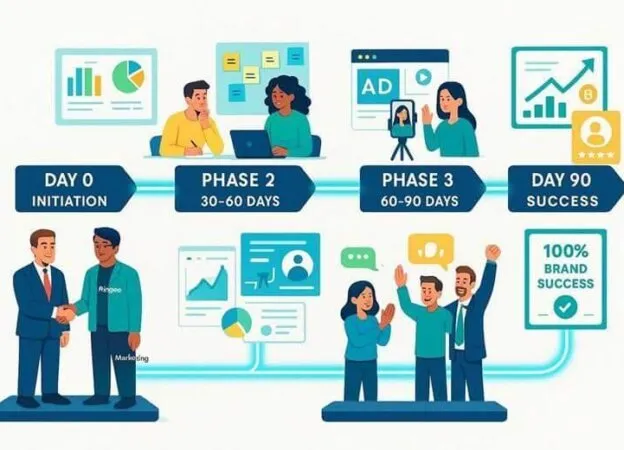Alright, so you’re thinking about diving into content marketing and creating a strategy that actually works. It sounds like a great idea, but let’s be real— to build an effective content marketing strategy is no small feat.
Table of Contents
It’s not just about posting random blog articles or shooting out a few social media posts. It’s about having a clear plan, setting goals, and making sure your content resonates with your audience. Before you start, let’s break down how to build a killer content marketing strategy, step by step.

Why Content Marketing Matters
First, let’s get one thing straight: content marketing isn’t just for getting clicks. It’s about creating value. Quality content helps you engage with your audience, build trust, and—let’s be honest—generate leads that convert into customers. Whether you’re selling products, services, or even ideas, content marketing keeps you relevant in a crowded space.
A well-crafted content marketing strategy helps you not only tell your brand’s story but also position yourself as an expert in your field. That trust translates into loyalty, and in the long run, customer loyalty equals revenue. So, yeah, content marketing matters.

Setting Clear Goals for Your Content Strategy
Before creating any content, you need to know what you’re trying to achieve. Whether it’s building brand awareness, generating leads, or increasing conversions, your goals will shape your content plan.
Ask yourself:
- What do I want my content to do?
- Who am I trying to reach?
- How will I measure success?
Once you have clear goals, break them down into measurable metrics—stuff like website traffic, click-through rates, or social shares. These metrics will act as a reality check to see if your strategy is actually working or if you need to tweak things as you go.

Know Your Audience Inside and Out
One of the most important steps in content marketing is understanding your audience. If you don’t know who you’re talking to, how are you supposed to create content that resonates?
Build a detailed buyer persona, which includes your audience’s:
- Demographics (age, location, income)
- Pain points (what problems are they trying to solve?)
- Interests (what type of content do they engage with?)
- Preferred platforms (where are they hanging out online?)
Understanding your audience’s needs and preferences will make it easier to create content they actually want to engage with. And when your audience is engaged, your content performs better, leading to more conversions.
Choose the Right Types of Content
Let’s be real—no one’s going to read a 3,000-word blog post every time you hit “publish.” The truth is, different audiences consume content in different ways. While long-form articles might work for one segment of your audience, infographics or videos might be more appealing to another.
Here are some popular types of content you might want to consider:
- Blog Posts: Great for SEO and providing in-depth information.
- Videos: Highly engaging and shareable, especially on social media.
- Infographics: Perfect for simplifying complex information and making it visually appealing.
- Podcasts: A great way to reach people on the go who prefer audio content.
- Case Studies: Showcase real-world success stories that prove your product or service works.
Mix it up, experiment, and find what resonates with your audience. Your content strategy should include a variety of formats to cater to different preferences.
Plan Your Content Calendar
Once you know your goals, audience, and content types, it’s time to get organized with a content calendar. A calendar helps you plan out your content in advance and ensures you’re consistently producing high-quality work.
Your calendar should cover:
- Content topics and themes
- Publishing schedule (how often will you post?)
- Key dates and holidays (any events worth capitalizing on?)
- Distribution channels (where will your content go?)
Having a solid content calendar ensures you never run out of ideas or scramble to create something last minute. Consistency is key in content marketing, and a calendar helps keep you on track.

SEO: Optimizing for Search Engines
There’s no point in creating amazing content if no one can find it. That’s where SEO (Search Engine Optimization) comes in. Optimizing your content for search engines helps ensure it ranks higher in search results, driving organic traffic to your site.
Here’s how to optimize your content:
- Keyword Research: Find keywords your audience is searching for and incorporate them naturally into your content.
- Meta Descriptions and Title Tags: Make sure they’re clear, compelling, and include your primary keyword.
- Internal Linking: Link to other relevant content on your site to keep visitors engaged.
- Quality Backlinks: Encourage backlinks from other credible websites to improve your site’s authority.
SEO isn’t just about stuffing keywords into your content. It’s about providing real value while making sure search engines can understand and rank your content effectively.
Distribute Your Content Across Multiple Channels
Creating great content is only half the battle—you also need to distribute it effectively. Post your content on platforms where your audience hangs out. This could include social media, email newsletters, or even guest posts on other sites.
Here’s a pro tip: repurpose your content across multiple channels. For example, you can take a long blog post and turn it into a series of social media posts, an infographic, or even a podcast episode. The key is to get your content in front of as many eyes (and ears) as possible.
Track, Analyze, and Adjust
You’ve put in all this effort, but how do you know if it’s working? Data is your friend here. Use tools like Google Analytics to track the performance of your content and see what’s driving traffic, engagement, and conversions.
Pay attention to:
- Page views
- Time spent on page
- Bounce rate
- Conversion rates
If something isn’t working, don’t be afraid to adjust your strategy. Maybe a particular type of content isn’t resonating with your audience, or maybe you need to rethink your distribution methods. Content marketing is all about iteration—try new things, measure results, and optimize as you go.

Measuring ROI of Your Content Marketing Efforts
Content marketing is an investment, and like any investment, you want to see a return. But measuring ROI (Return on Investment) in content marketing isn’t always straightforward. Beyond just tracking clicks and views, you want to understand how content is impacting your business’s bottom line.
Here’s what to keep an eye on:
- Lead Generation: Is your content capturing leads through forms, downloads, or subscriptions?
- Sales Conversions: How many of those leads convert into paying customers?
- Customer Retention: Does your content help retain customers by providing ongoing value?
While it might take time to see a direct ROI from content marketing, patience and consistency are key. Keep producing quality content, measuring performance, and tweaking your strategy along the way.
Start to Build an Effective Content Marketing Strategy Now
Building an effective content marketing strategy isn’t about creating random pieces of content—it’s about having a clear plan, setting measurable goals, and producing high-quality, valuable content that resonates with your audience.
Know your goals, understand your audience, optimize for search engines, and distribute your content across the right channels. By tracking your results and adjusting as needed, you’ll create a content strategy that drives real results and sets your brand apart from the competition.
Content marketing takes time and effort, but when done right, it’s one of the most powerful tools in your marketing toolkit. Keep it real, keep it relevant, and watch your brand grow.



